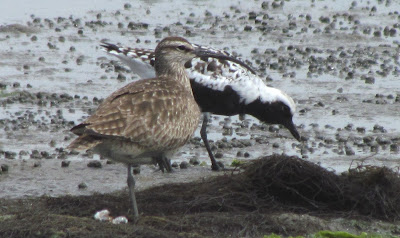Beryl is almost upon us. Tropical depression Beryl, that is – I guess she’s unhappy that her status has been downgraded! Anyway, the storm is set to dump rain and high winds on the Triangle area, and out of fear they could be M.I.A in the coming days (and no, I don’t mean they’re going to become international hip-hop stars), James and I took a chance and visited the nesting Warbling Vireos of Lake Shelley.
When we left, the sky was a monotonous overcast, but by the time we reached Raleigh , bright spots and blue blotches appeared among the clouds. Almost as soon as we left the parking lot, I could hear the incessant ramblings of a male Warbling Vireo calling from atop one of the nearby sycamores. At least I’m told they’re sycamores – I’m really bad at trees. Unfortunately, we were totally unprepared for the sun when the clouds broke, and the by the time James compensated for the light, the male jumped down from his singing perch and flew off. Still, a lifer is a lifer, and he got his shot.
 |
| Vireos just aren't very photogenic - we don't have good pictures of any! |
We could never find the reported nest (mostly because I forgot my binoculars – more on that later), but I was able to view one of the Warbling Vireos quite closely. A large Common Grackle got a little to close to the nesting area, and a vireo swooped down, chasing the large blackbird out of its territory, and landed at a nice eye level. Using a detached spotting scope, I got my best view of a Warbling Vireo since I was in college, watching one sing along Beaver Lake Asheville .
While the Warbling Vireos may have been our immediate target, the sure-fire birds were just a MacGuffin to get us out towards the Shelley Lake
 |
| This bundle of feathers, to be exact. I'm still not sure how I ever spotted it, but I remember my heart skipping a beat when I did! |
Immediately I called James on his cell phone, telling him simply: “I’ve got one.” He sprinted the half-mile back to my location, but at the time I couldn’t tell if the owl was even the Great-horned we were looking for – it could have been a more common Barred Owl, or even a juvenile of either species. As James ran up, the owl reached over and scratched his chin, revealing twin tufts of feathers. We’d found our bird, and maneuvered slightly to get into prime viewing position.
 |
| I watched through the scope as he peered down at us - he seemed to be looking into our souls! |
Almost immediately after reaching our optimal spot, two things happened. For one, the clouds totally broke, and light shone upon the bird who clearly thought he was hidden in a dense tangle of pine needles. Secondly, a large mixed flock of American and Fish Crows started calling from just above our heads. We were afraid we’d betrayed the owl’s position, but he kept his cool and stayed put. Eventually the crows flew off, perhaps pursuing a different predatory bird – or even a second owl! The Great Horned Owl watched them depart into the distance, almost oblivious to our presence. Another lifer for James, and another bird I've only seen once before.
 |
| It's the first one I've found roosting during the day - makes for a totally different experience! |
On the way back from our owl adventure, James and I couldn’t help but visit the Warbling Vireo one last time. Same as before, the male flitted between the sycamores, singing constantly. The only difference is he stayed in the same spot for more than a couple seconds, and James was able to get a shot of his lifer that he was finally happy with. While we sat there, staring up into the tree, a couple passing walkers (/not zombies) asked us what we were looking at. Was it an owl nest? A heron nest? They’d seen a heron a couple days ago, it must’ve been six feet tall, they said.
 |
| Why, does it look like a heron or something? |
No, it was a Warbling Vireo. “That doesn’t mean anything to me,” she replied. “I know,” I replied, a knowing smirk on my face. “It’s kind of a birder’s bird.” The walker shrugged and walked off, not realizing that she’d passed up a creature wholly unusual in our neck of the woods. It’s too bad they couldn’t enjoy it like James and I did, but it’s her loss – just means more birds for us!











.JPG)






































